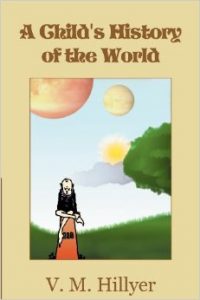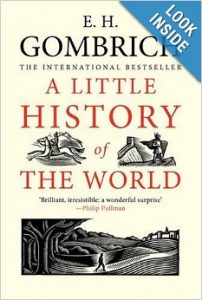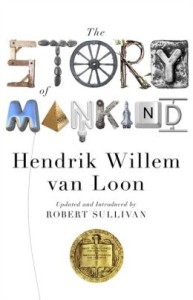One thing we’ve lost, in our modern fragmented world, is a sense of the story of history. Between the rock of political correctness on one side and the hard place of scientific data analysis on the other, the narrative flow gets ground up and spit out in unconnected pieces. Narrative history has its faults, the greatest one being that the story of the world is so vast that something has to go, and it’s usually the stories of what we often call “minority” groups. Africans in Africa would rightly object to being called a minority, yet the fact remains that certain major themes and cultures have dragged world history in significant directions that kids need to know about. All cultures deserve to have their stories told, but not at the expense of the overarching narrative.
For that reason, older world history books, in spite of some outdated facts and prejudices, are still worth reading. The main reason is that they present history as a narrative whole, and are often written with a verve and style that most contemporary histories, written either from a sense of grievance or over-analysis, seriously lack. I’m thinking of three classic histories in particular: A Child’s History of the World (originally published 1924), The Story of Mankind (1921), and A Little History of the World (1936). Interestingly, in the earliest editions all three of these ended with World War I, as though the authors believed that awful conflict truly was “the war to end all wars” and therefore it was time to write a comprehensible world history for children. Obviously that wasn’t the case, so all have been revised, to a greater or lesser extent, more than once.
A Child’s History of the World, by V. I. Hillyers. BN Publishing, 2012 (latest ed.), 460 pages. Age/interest level: 6-9
When I was homeschooling back in the late 1980s, V. I. Hillyer’s Child’s History was the bee’s knees—all my friends recommended it, and yet I never got around to buying a copy. The author may have had homeschoolers in mind when he wrote it, because he was the first headmaster of the Calvert School, a Baltimore day school that under Hillyer’s direction developed a home-based curriculum that’s still in use. Aimed at early readers in second or third grade, the scope is general, hitting only high notes of “history’s greatest hits.” But therein lies its value: a broad thematic river on which kids can launch more specific craft as they get older (how’s that for metaphor!). Written in a friendly, conversational style, the narrative was originally divided into 79 chapters, most recently expanded to 99 with the updates.
A Child’s History workbook and manual are also available from Calvert. Since I never read the original book, I can’t honestly say much more about it—hence no worldview and literary ratings. But here’s a useful review from someone who has.
A Little History of the World, by E. H. Gombrich. Yale University Press, 2008 (latest ed.), 304 pages. Age/interest level: 8-12.
 A Little History was originally published in German. Ernst Gombrich was a native of Austria, an art historian (who would become better known for The Story of Art, published several years after the history). The preface to the new edition, written by his granddaughter, tells how Ernst was asked to translate a British world history for children and was unimpressed by the content. “I can probably write a better one,” he told his publisher friend. “Fine,” said the publisher; “do it. But I need it in six weeks.” Ernst began writing about the time he met his future wife, and accomplished a courtship and a complete manuscript in the required time. Years later, after he’d become a British citizen, he himself translated the book into English.
A Little History was originally published in German. Ernst Gombrich was a native of Austria, an art historian (who would become better known for The Story of Art, published several years after the history). The preface to the new edition, written by his granddaughter, tells how Ernst was asked to translate a British world history for children and was unimpressed by the content. “I can probably write a better one,” he told his publisher friend. “Fine,” said the publisher; “do it. But I need it in six weeks.” Ernst began writing about the time he met his future wife, and accomplished a courtship and a complete manuscript in the required time. Years later, after he’d become a British citizen, he himself translated the book into English.
He organized chapters by asking himself what events of the past had touched the most lives and had the greatest effect. The result is Euro-centric, at least after we come to Alexander the Great, with excursions to Asia and India and almost nothing about sub-Saharan Africa or South America. Coming in at about 300 pages, that’s probably the best anyone can do. What he covers, he covers well, with a bit more detail in some areas than A Child’s History. Like all the books in this review, he adopts a conversational style that often raises questions in the text and addresses the reader as “you.” He also includes personal touches, such as his tongue-and-cheek judgment that the Egyptians were “quite right” to worship cats. His attitude toward Christianity is traditional rather than devout—he respects the role of Christian faith in shaping western culture and is not as judgmental toward Christian leaders as contemporary writers often are. But he doesn’t leave any clues that he actually believes it. His account of Jesus goes straight from the crucifixion to the growth of the church, with no hint that Jesus rose again, or even that his followers thought he had. Van Loon (see below) does the same; I suspect that sort of worldview was common among mid-century Europeans—a respectful, not-completely-disillusioned view of religion and mankind that was soon to be smashed by the rise of the Third Reicht.
Besides narrative flow and readability, the thing I appreciate most about A Little History is its reflections on history itself, scattered throughout. For example: “If you want to do something new you must first make sure you know what people have tried before.” In the closing chapter, written in the 1970s, the author looks back over the intervening years since the first publication of his book and notes a few things he got wrong because he was living too close to it at the time. He notes how a reader of history must be discerning: “One of the things I also learned was not to believe everything I read in the newspapers.” History is an inexact science—actually more of an art, and it’s interesting that all three of these authors wrote art histories as well. It’s hard, and perhaps impossible, to get at the objective truth, but Gombrich is an example of someone who tried his best.
One negative note about the formatting: simple woodcut illustrations head each chapter and essential maps occasionally break up the narrative. But the paragraphs are long, and many page spreads present an intimidating lack of white space to the print-shy. Breaking up the narrative with headings or more illustrations would make it more kid-friendly (and there is an illustrated edition, but I haven’t seen it). On the other hand, the chapters are short.
- Worldview/moral value: 4 (out of 5)
- Literary value: 5
The Story of Mankind, by Hendrik Willem van Loon. Liveright Publishing, 2013 (latest ed.), 736 pages. Age/interest level: 12-16.
When I was a kid, my parents owned a volume of Van Loon’s Lives, a whimsical approach to biography history in which the author, writing as himself, moves back to his home town of Rotterdam (though he  was a naturalized American citizen) and rents an old house that turns out to have the magical property of calling up any historical figure he cares to meet. Thus begins a round of dinner parties, each with anywhere from one guest to four, resulting in delightful conversation (e.g., Thomas Jefferson) or wild breaking of crockery (some early Christian bishops). That was my introduction to Van Loon (pronounced, in the Dutch way, the same as “loan”). Only much later did I learn that he won the very first Newbery award, in 1922, for The Story of Mankind.
was a naturalized American citizen) and rents an old house that turns out to have the magical property of calling up any historical figure he cares to meet. Thus begins a round of dinner parties, each with anywhere from one guest to four, resulting in delightful conversation (e.g., Thomas Jefferson) or wild breaking of crockery (some early Christian bishops). That was my introduction to Van Loon (pronounced, in the Dutch way, the same as “loan”). Only much later did I learn that he won the very first Newbery award, in 1922, for The Story of Mankind.
So far as I know, every Newbery book is still in print, and since so much history has happened since the twenties, there have been several revised editions of The Story of Mankind (there was even—inexplicably—a movie version produced in the 1950s). My edition ends in the late 70’s. The last chapter written by Van Loon himself ends with the period between the two World Wars; subsequent chapters were written by his son Willem . . . and others. Speaking generally, you might opt for an earlier edition, as later ones are almost sure to be suffused with the fragmentism that hounds today’s study of history. You will also fewer pages to deal with; my 1984 edition weighs in at just less than 600 pages, while the latest is a hefty 736.
Like the other two histories, this one is written in an informal, even chatty style that asks lots of thought questions and often talks directly to “you.” The author was a classical humanist; his all-time favorite historical character was the urbane, witty, semi-secular monk, Erasmus, while John Calvin holds a place near the top of his hate list. I would call him an amiable agnostic, of the same sort as those other great world-history chroniclers, Will and Ariel Durant. To him, Christianity was fine as long as it was leading Europe out of the dark ages, but perhaps by now it has outlived its usefulness. That said, The Story of Mankind moves right along with more detail and attention paid to personality than the other two. For that reason alone it’s worthwhile; we get a better sense of how history has been driven by outsize personalities, at least since the dinosaurs. Some outdated information regarding early humanoids (“cavemen”) is only to be expected in the early chapters of all three books, given their publication dates, but any reader can skip over those and go right to the early civilizations. Van Loon drew his own illustrations, maps, and charts, in a rather casual style that suits his narrative. Generally these are helpful, and some, like the closing “Animated Chronology, are even fun.
- Worldview/moral value: 3.5
- Literary value: 5
One last note: Susan Wise Bauer’s multi-volume Story of the World: History for the Classical Child, was written within the last few years to accompany a classical learning approach. The influence of Hillyers, Gombrich, and van Loon (or at least some of those guys) is evident: a readable, story-based style, many direct addresses to the reader, and perhaps too many exclamation marks. I haven’t dug very deep into these, but they represent a return to narrative history that we desperately need.
Support our writers and help keep Redeemed Reader ad-free by joining the Redeemed Reader Fellowship.
Stay Up to Date!
Get the information you need to make wise choices about books for your children and teens.
Our weekly newsletter includes our latest reviews, related links from around the web, a featured book list, book trivia, and more. We never sell your information. You may unsubscribe at any time.
We'd love to hear from you!
Our comments are now limited to our members (both Silver and Golden Key). Members, you just need to log in with your normal log-in credentials!
Not a member yet? You can join the Silver Key ($2.99/month) for a free 2-week trial. Cancel at any time. Find out more about membership here.
3 Comments
Leave a Comment
You must be logged in to post a comment.


Some other books that fit your criteria are written by H. E. Marshall, such as Our Island Story (history of Britain) and This Country of Ours (American history). Both were written in the early 1900s. We have greatly enjoyed reading these with our grade-school students, and I’m embarrassed to admit that I learned so many things I hadn’t known previously!
I agree, Linda. We just listened to H.E. Marshall’s Stories of Beowulf Told to the Children. My kids were mesmerized.
Have to add my appreciation for Henrietta E Marshall’s books. I learned a great deal from Our Island Story over this past summer reading along with my daughter. We are using her Story of Europe (along with Churchill’s Birth of Britain) for history, and her English Literature for Boys and Girls for a literature overview this year.